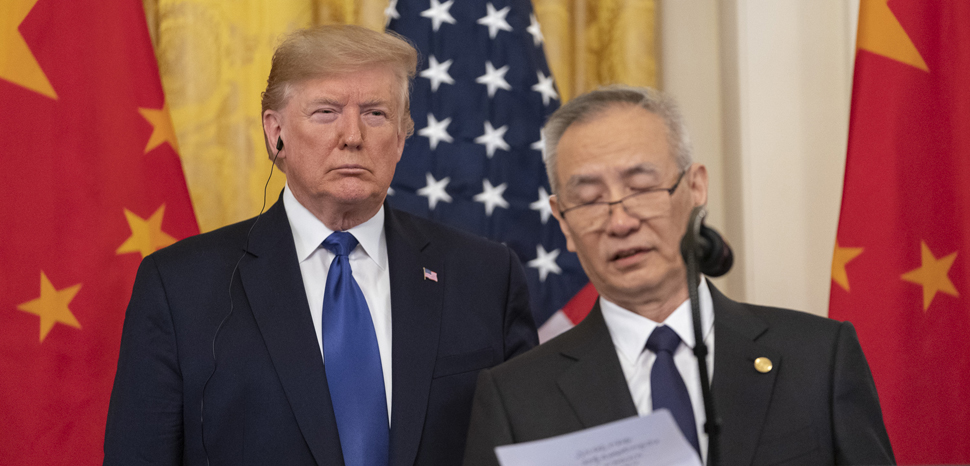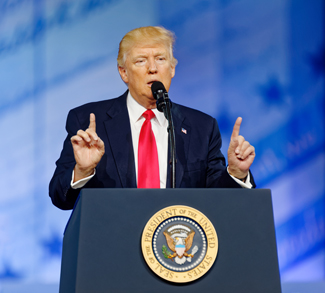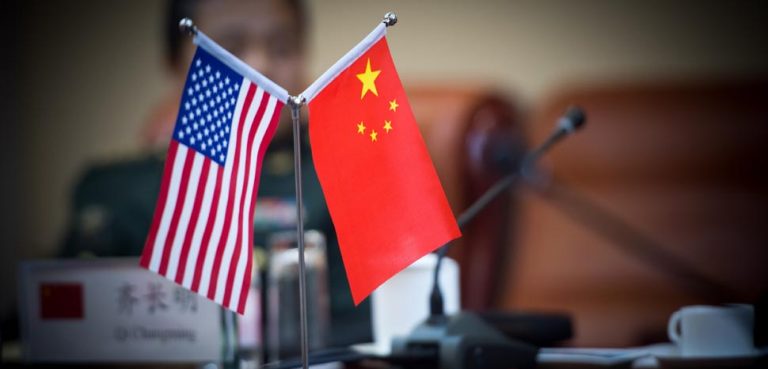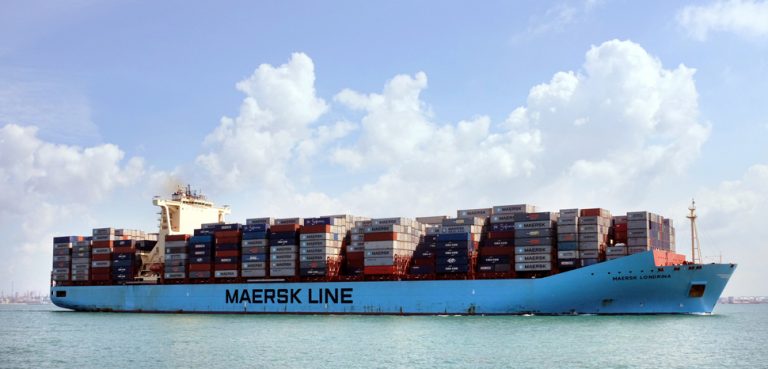Until President Donald Trump took office in January 2017, little was emphasized in the mass media or in any president’s previous rhetoric regarding the overwhelming trade deficit that was occurring in the United States (US). In 1984, under President Ronald Reagan, the US trade deficit hit a record high of $123.3 billion, a number that far surpassed the imports over exports total of $69.4 billion. In 1983, the administration considered a “trade deficit,” writes Peter T. Kilborn in the January 31, 1985 edition of The New York Times, “a small, even desirable, price to pay for a healthy economy with a strong dollar and low inflation.” The Reagan administration succeeded in stabilizing inflation and reduced unemployment but its achievements came at a cost with economic growth being inherently flawed.
Reagan began his presidency with $965 billion in debt, and ended it eight years later with $2.74 trillion, a trend ushered in by Reagan that would continue throughout the next five sitting presidents. George H. W. Bush elevated the national debt further, bringing it to $4.23 trillion by the end of his four-year term. This increase ebbed slightly following Bill Clinton’s election with the federal debt rising to $5.77 trillion after his eight years in office. Owing to the “War on Terror” and subsequent military and security expenditures, President George W. Bush more than doubled the national debt, bringing its total to $11.1 trillion after his two terms. Although President Barack Obama’s rise in federal debt failed to maintain the same pace as his predecessors, he still left office in 2017 with over $19.85 trillion in debt. National debt growth under Obama is, however, quite misleading with the “Great Recession” having significantly impacted the national deficit even before Obama assumed office.
Donald Trump took office in 2017. During his four years as president, he will have added $6.6 trillion in deficits and was originally projected to add approximately $8 trillion despite having been elected on the promise of reducing or eliminating the US trade deficit. His total deficits are tightly intertwined with the global pandemic and the US’ response through Trump’s declaration of a state of emergency and Congress passing the $2 trillion CARES Act, in addition to a number of other stimulus measures deemed essential for the protection of the US economy, though the spending outcome may have been different had the US federal government planned differently. The Congressional Budget Office (CBO) estimated these factors would have a deleterious effect on the federal deficit. Trump’s skyrocketing deficits can, to a considerable degree, be accredited to external forces and their impacts on the United States. Trump, nonetheless, lost his battle with the national deficit and has failed to secure a second term during which he may have been able to follow through on this original election promise or immerse the US deeper in debt.
The trade deficit emphasized throughout President Trump’s campaign became an avowed reason as to why the US economy was slowing down and the unemployment rate was increasing. Trump, in true political fashion, promised to reduce the trade deficits by attacking China and many key US allies in an effort to save US jobs and enhance the economy. Although he has kept to his word and “attempted” to decrease the deficit, it has been to no avail and instead resulted in ballooning the deficit even further. This may be due to his position that by attacking his closest allies and imposing tariffs on many Chinese, Canadian, and Mexican products, he would solve his woes. We detail firstly how the deficit has been growing as a result of an increase in the US’ purchase of foreign products and Trump’s decision to cut taxes, which consequently have resulted in inflating the national debt even further and forcing the US to borrow more from foreign investors to fund its consumption. We then articulate that Trump’s use of tariffs has been sorely misguided and has only served to magnify the trade deficit rather than mending it, resulting in, again, the national deficit increasing astronomically under Trump’s rule.
Ballooning the Trade Deficit
One of President Trump’s first promises after being sworn into office was to both cut taxes and to “Make America Great Again” by getting US citizens back to work by limiting the mass importation of goods that could be produced within the country, such as automobiles. Within one month of his presidency, he had stopped a Ford automobile plant from moving to Mexico, and “saved” thousands of jobs at its original factory in Michigan. Later, he signed the Tax Cut and Jobs Act which legislated an approximate $1.5 trillion tax cut that saw a 30% reduction in the corporate tax alone. With these two fiscally conservative actions, Trump instantly became a national “hero” to many. He subsequently reduced the unemployment rate to a record 3.9%, energized the economy, helped appreciate the US dollar – or increase the dollar’s buying power on the international market – and facilitated the boost in production of US goods to aid in the decrease of their consumption of foreign products. Looking at these statistics alone would lead many people to the understanding that Trump’s economic policies, explicitly his increase in ad valorem tariffs – that increase the price of a product by a fixed percentage – resulting in a trade war with China and his surrounding allies would work, right?
When the US economy was booming in 2019 and the unemployment rate was at its lowest point since 1968, it was expected by many of Trump’s supporters that his promise of decreasing the trade deficit would come true, but instead, they saw it ballooning even further. This is due to firstly, President Trump’s narrowly minded fascination with solely the current account in the US balance of payments, while seemingly ignoring the capital account though it is of equal importance. The balance of payments (BoP) is essentially a list of the transactions that flow in and out of the US. The BoP is split into two sections, the capital account, which is the flows of capital – often times seen through foreign direct investment – and the current account, which encompasses imports and exports. The capital and current account should always balance out to 0. Due to th e ongoing trade deficit in the US, this means that the country is importing more than it is exporting and thus, running a current account, or trade deficit. The current account deficit, in turn, requires the capital account to run a surplus to maintain the balance of payments, meaning that there are large flows of capital coming into the country in the form of investment. With President Trump’s decision to slash taxes and implement de-regulation amongst corporations, he created an atmosphere that resulted in more foreign firms entering the US market because of low-tax incentives. By bringing in more foreign firms he has consequently increased the capital account surplus. which inherently implies a current account deficit. By explicitly ignoring the US capital account, he limited his administration’s ability to decrease the trade deficit and has in fact, exacerbated it.
e ongoing trade deficit in the US, this means that the country is importing more than it is exporting and thus, running a current account, or trade deficit. The current account deficit, in turn, requires the capital account to run a surplus to maintain the balance of payments, meaning that there are large flows of capital coming into the country in the form of investment. With President Trump’s decision to slash taxes and implement de-regulation amongst corporations, he created an atmosphere that resulted in more foreign firms entering the US market because of low-tax incentives. By bringing in more foreign firms he has consequently increased the capital account surplus. which inherently implies a current account deficit. By explicitly ignoring the US capital account, he limited his administration’s ability to decrease the trade deficit and has in fact, exacerbated it.
Secondly, the US has exhibited a rise in US consumption as a direct correlation to Trump’s economic policies because of the resulting increase in per capita income. According to the determinants of demand, when a states’ average income rises and their currency appreciates, consumers in the US are expected to spend more money and concurrently, buy more products that are usually from abroad due to both their increased access to capital as well as the higher buying power of the US dollar. This has remained true in the US even with its recent mercantilist economic policies that attempt to stop the consumer from purchasing foreign products and instead, keep their money in the country. However, due to the relatively low-cost of foreign products, such as those imported from China, Americans found that they are consuming more imported goods, only aiding in the deficit increasing.
Trump misguidedly failed to exhibit the understanding that in order to cut the trade deficit, he not only should be concerned about the importation of products, but more importantly the spending habits of the American populace. In order to fund the American citizenry’s increase in consumption, the US government is forced to borrow more from abroad – often times from either China or Japan – resulting in capital flowing back into the country through the capital account. This, again, helps to balloon the trade deficit because in order to maintain an equilibrium of the balance of payments, the US is forced to run a current account deficit. Thus, due to the increased consumption by US citizens, the US is forced to borrow more capital from foreign investors, increasing capital flows into the country and aggravating the one thing that Trump said he would minimize – the trade deficit.
Why are Tariffs Not the Answer?
Even in the 18th century, when Adam Smith was composing the Wealth of Nations, economists were becoming well-aware of the negative effects that tariffs had on a state’s economy and that they were not beneficial in the long-term for the country and should simply be avoided. Although Smith, similar to Trump, believed that a state should, writes Douglas A. Irwin, “diminish as much as possible the importation of foreign goods for home consumption, and to increase as much as possible the exportation of the produce of the domestic industry,” he would surely disagree with how Trump sought to diminish the amount of imports the US obtains. Smith recognized that although tariffs were beneficial in the short-term because they increased employment and output in certain sectors that received protection, they were detrimental in the long-term owing to the fact that they would eventually result in a monopolistic dictatorship and prevent free trade from occurring, causing consumers to be charged higher prices for goods due to the loss of competition.
Although many economists after Smith have elaborated on his idea of free trade, he was one of the first economists to truly comprehend the detrimental effects that tariffs can have on a country, and instead pushed for free trade policies that allowed a state to pursue its absolute advantage in a product. Absolute advantage meant that a state should specialize in the production of a certain good that they can produce the most efficiently and then expand production to trade with other countries. Trade then becomes mutually beneficial for all parties involved because both resources and labour are allocated more efficiently in the production of the goods in comparison to if the US, for example, attempted to produce all the goods its populace required. If a state chose to implement a tariff, in comparison, production of certain goods would have to be increased past a corporation’s efficient capacity, resulting in the good not being produced as aptly in the home country as it could be abroad. Tariffs, although are a deterrent to consumption, do not completely disqualify a particular good from the market, resulting in many goods with tariffs still being purchased by the consumer. The consumer is then forced to pay a higher price for the good because of the tariff, due to the higher market value. The American populace, because of the implementation of tariffs on certain imports, would then have to pay for these tariffs out of their own pockets given that the producer forces the financial burden from themselves to the consumer, effectively harming citizens at home instead of the intended foreign corporation.
Although consumers in the US have been financially burdened because of the implementation of tariffs on a high quantity of the goods they demand, we saw the US going through a period of increased employment as well as greater production in certain sectors, such as manufacturing, because of the implementation of tariffs that are protecting American industries and allowing them to hire more workers. This, of course, all came to a grinding halt with the onset of the COVID-19 global pandemic and its impact alongside the government’s anti-pandemic measures that have had a debilitating effect on Americans and the citizens of many other countries. Despite their exceptionally brief benefits, these tariffs have also resulted in reciprocal “tit for tat” tariffs being added to US goods, such as the 25% ad valorem tariff on soybean products being imported to China. These retaliatory tariffs, in turn, have caused soybean farmers in the mid-west to struggle finding buyers for their produce and has hurt the economies of states such as Tennessee where soybeans are one of their largest exports. Smith, in comparison, did believe that tariffs were beneficial if they were used in a retaliatory fashion, which China has showcased, but this was the only exception and should be only temporary in form as it can complicate the use of free trade and can hamper a state’s progress in the importation of goods due to the increase in price per product. Thus, free trade should be pursued unless such extremely specific circumstances arise, because although tariffs can assist with defending certain industries by providing them protection in the international market, such protection will eventually stimulate a boomerang effect and be at the detriment to the whole state, demonstrated when Smith contended, “the gain of the town is the loss of the country.”
What Now?
In his article, “Why the Trade Deficit is Getting Bigger – Despite All of Trump’s Promises,” David Lynch stresses the fact that Trump misled the American populace into believing that tariffs on foreign products would solve the inherent “problem” of the trade deficit, when in fact, the US economy would suffer extraordinary setbacks in the future due to Trump’s protectionist policies. Lynch asserts that cutting taxes as well as “removing Congress’ limitations on government spending” culminated in the economy growing and consumption increasing, effectively ballooning the deficit even further. Trump’s realization that his protectionist p olicies have ballooned the deficit forced him to seek out other opportunities to reduce spending that the trade deficit has exacerbated. Trump then announced cuts to government spending while assuring the US populace that Medicare, Medicaid, and Social Security, three institutions that encompass 60% of the national budget as of 2015, would not receive cuts and that the military would only receive a small reduction in spending from $716 billion to $700 billion. These reductions, or lack thereof, could hardly affect the $21.7 trillion government deficit and were destined instead to continue to grow the deficit because of the increased expenditures Medicare, Medicaid, and Social Security require due to the aging population of the US. As well, much of Trump’s voter-base is comprised of middle-aged and elderly people who depend on the welfare state and therefore limited Trump’s ability to cut these programs if he hoped to be re-elected in 2020. Thus, the only other viable way to limit the trade deficit would be to increase taxes to lessen the amount of borrowing from foreign investors, which would in-turn decrease the capital account surplus that would then allow the current account to balance with a less severe deficit. However, Trump was never likely to capitulate to this necessary evil.
olicies have ballooned the deficit forced him to seek out other opportunities to reduce spending that the trade deficit has exacerbated. Trump then announced cuts to government spending while assuring the US populace that Medicare, Medicaid, and Social Security, three institutions that encompass 60% of the national budget as of 2015, would not receive cuts and that the military would only receive a small reduction in spending from $716 billion to $700 billion. These reductions, or lack thereof, could hardly affect the $21.7 trillion government deficit and were destined instead to continue to grow the deficit because of the increased expenditures Medicare, Medicaid, and Social Security require due to the aging population of the US. As well, much of Trump’s voter-base is comprised of middle-aged and elderly people who depend on the welfare state and therefore limited Trump’s ability to cut these programs if he hoped to be re-elected in 2020. Thus, the only other viable way to limit the trade deficit would be to increase taxes to lessen the amount of borrowing from foreign investors, which would in-turn decrease the capital account surplus that would then allow the current account to balance with a less severe deficit. However, Trump was never likely to capitulate to this necessary evil.
Trump’s efforts to “protect” US industry have resulted in increasing investment and capital flows into the country, while also ballooning the trade deficit and negatively affecting many US corporations that are now struggling under tariffs in addition to the added pressures of the global pandemic. With Trump’s inadequate knowledge of both basic international economic practices as well as the balance of payments of the US, his policies have effectively resulted in expanding both the trade deficit and concurrently the national deficit. To solve these ills, the Trump administration would have needed to either curb spending by a larger degree or limit capital inflows into the US through some alternative form that does not involve the enactment of tariffs. This would have then helped the current account’s deficit decrease by not being pressured as strongly by the capital account because of the enormous capital flows coming into the US. By decreasing the capital account surplus, the US would have inevitably seen a decrease in the trade deficit and overall, the nation’s deficit. Although Trump may have realized that drastic changes needed to be made to the US overall budget, he failed to act on any such awareness. Though the American populace will not have the opportunity to see how his fiscal policies play-out in a second term, Trump, based on his single-term performance, would have likely chosen ineffective policies and would have ended-up magnifying the national deficit further.
The views expressed in this article are those of the authors alone and do not necessarily reflect those of Geopoliticalmonitor.com or any institutions with which the authors are associated.




